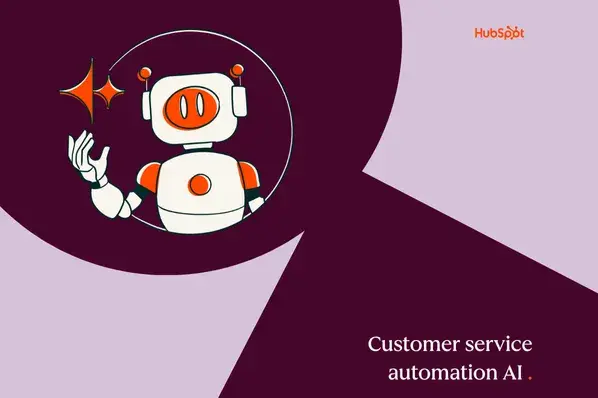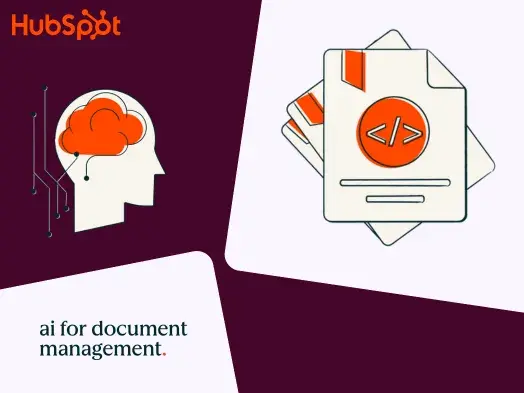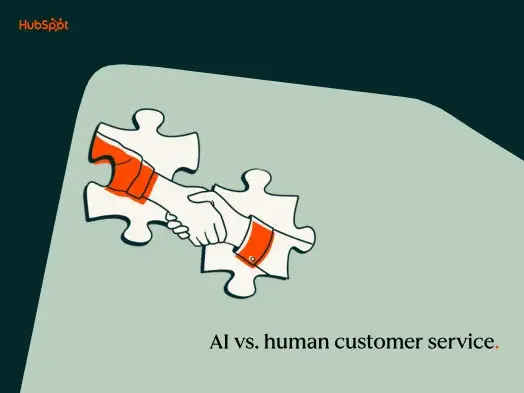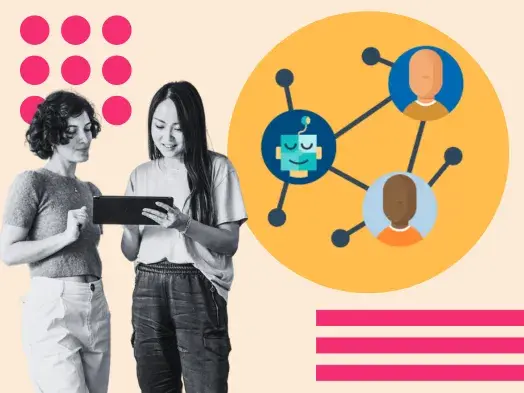So, how does AI really measure up when customer service gets complex? Is it edging out human reps, or is it giving them a new way to shine?
Let’s review what I found, see where AI nails it and where it doesn't quite hit the mark, and discover why those of us in the business might start seeing AI less like competition and more like a co-conspirator in making customers happy.
Table of Contents
- AI Service Response Challenges
- Perks of AI in Customer Care
- The Bumps on the AI Implementation Highway
- The Extra Edge AI Brings to the Customer Service Table
AI Service Response Challenges
In this section, we‘re squaring off human customer service pros with AI to see who comes out on top in the real-world arena. I’ve lined up some challenges that play to human strengths — let's see if AI can keep up.
As a benchmark, I presented all of these scenarios to Jonathan Dorosh, a senior customer success manager at HubSpot. He’s got almost five years of experience in the customer success realm. Let’s see how AI squares up.
Scheduling a Meeting
In the first challenge, I matched a seasoned pro against ChatSpot, HubSpot’s AI-powered CRM. In my fictional scenario, the customer needed to reschedule an important demo at the last minute, which required quick and precise coordination.
Human Response: For this simple task, Dorosh says he would note that rescheduling is no problem, sending an email to make the process super easy.
“I‘d insert a few specific availabilities for my calendar over the next few days. And if none of those work, I’ll note that you could book anything anytime I'm free via my HubSpot [calendar] linked in my email,” Dorosh says.
The Prompt: I have a customer who needs to reschedule an important demo last minute. Our original call was for December 16 at 12 p.m. ET. Please write me a response with available timeslots on the 17th. I am free at all times except 10 a.m.-1 p.m. ET. The call will last 50 minutes.

AI Response: ChatSpot efficiently recognized keywords related to scheduling and provided immediate automated responses with alternative slots. This took just as much time as writing the email. If your schedule is packed, you can hand off a simple task like this to a chatbot.
However, be sure to insert a calendar link like Dorosh recommends so people have the option to book time with you beyond these slots.
Takeaway: AI can help craft standard, professional language for your tasks. This is a great way to save a few minutes or draft an email on a busy day.
Understanding Complex Requests
Next up, a head-scratcher of a support ticket: think product specs, price tags, and how it all plays nicely with the tech they already have.
Let’s say a current customer is considering upgrading their account from a professional plan at HubSpot to an enterprise plan. They want to support 15k marketing contacts. The customer wants to know if an upgrade is worth it, considering they have a tight budget. How would you go about recommending a plan?
Human Response: If presented with this scenario, Dorosh says he would lead with clarifying questions. This would help him better understand their needs and what plan would suit the customer best.
“The first thing I would do is dig a little bit more into their intention behind the upgrade,” says Dorosh. “So what specific features they're looking for that are good behind the enterprise that they see value in. I think when it comes to marketing contacts, enterprise has more beneficial economics for the pricing.”
However, there’s more than just pricing. Dorosh says he would discuss the other benefits that come with an upgraded account, like reporting features and other tools the account holder would get access to.
“Those would probably be the two areas I focus on first,” Dorosh says. “And then from there, I personally would loop in our sales staff... This helps speak a little bit more to discounting options, promotions, anything we're running, and lead the pricing conversation from there.”
The Prompt: I have a current customer who is wondering if they should upgrade their account from a professional plan to a HubSpot enterprise plan. They have 15k marketing contacts. They have a tight budget and want to know if it's worth the upgrade. Please write me a response and recommend how I should respond.

AI Response: The AI took a stab, sectioned the question, and clarified the basics of features and costs. But when things got technical with integrations, it threw in the towel and tagged a sales rep in for backup. Additionally, the AI email response doesn’t sound very human. It does little to highlight the benefits of the upgrades in a specific way.

Takeaway: AI has the chops for slicing up questions, but it‘s not ready to cook up the full meal deal yet. It’s the one you tag in for the opening act, not the main event. Real reps have a better understanding of your product. They can tailor solutions and content customers to other people on relevant teams to get the job done.
If you’re new to the role, AI can help you build an outline for a plan of action. However, be sure to add information based on your knowledge or tap a colleague for help.
Handling Sensitive Customer Scenarios
Time for the touchy stuff: A customer is upset that there was a product outage when they have a major presentation. They need to pull data from their CRM to get the task done. If they can’t get the information, they’ll miss a deadline.
However, it’s not possible to solve the outage immediately. What do you do?
Human Response: Dorosh says that he has experience dealing with outages, though perhaps nothing as extreme as I described in my fictional scenario. However, he was all in.
“Leading with empathy and a bit of an apology up front definitely helps level with them and hopefully de-escalates the emotions, which I'm sure are pretty high,” he starts.
From there, Dorosh says he would share the most recent update about the outage as an internal employee.
“I acknowledge that there‘s something wrong and that our team’s working to resolve it,” Dorosh says. “Sometimes we have valid phone numbers. If we do, I'll give them a quick call and explain the situation. I think it comes off a little bit better via phone than email.”
From there, Dorosh notes he would follow up with any resources that can help and provide status updates as they become available. He wants to be “a point of contact that they can reach out to” as the issue gets fixed.
The Prompt: I have to respond to a customer complaint about a product outage. They have a major presentation tomorrow and are not able to pull data from the CRM. We do not know when the issue will be resolved. Please write me a response with empathy.

AI Response: The response from AI feels canned and lengthy. Having a customer read a long apology won’t do much to resolve the issue.
Takeaway: On the emotional battlefield, humans are the undisputed champs. AI’s just not equipped for the front lines when the heat's on. Plus, your human helpers can get in touch with people over the phone or video chat. They can provide up-to-date information that they’ve heard from teammates.
Outages are no fun, but customers are more forgiving when they have top-notch service. AI responses feel canned and may make your users feel less valued.
Sounding Human
Here's a curveball. Emails from humans sound personal. They may mention something about the receiver — how are the kids or how was your vacation? Or, perhaps they say something about the sender. How we use language varies by region. That may include local lingo and homegrown expressions.
Let’s see how humans and AI use expressions and personalization to connect with real humans. Our reason for reaching out: a check-in email.
Human Response: During our interview, I asked Dorosh to write me a check-in note. He responded to me with a message that acts as a starting point for his email. We chatted in mid-December, so his note had a festive flair.

From there, he’ll find ways to add personalization.
“I’d insert some product-specific things that I‘ve picked up on to personalize it a little bit further so it’s not just like a general checking-in message,” Dorosh says. “If there‘s anything notable from a previous conversation, the last time we connected, I’ll insert that — or anything specific to their brand.”
Dorosh says he gets a better response rate if his messages have a personal touch and don’t feel general. However, he notes it’s important to sound authentic.
“I've seen…examples of sales emails that try to be personable to a degree, but it just comes off as not authentic,” he says. “I try to avoid anything too out there.”
The Prompt: I'm based in Boston. Please write me a check-in email for my customer that shows I live in the area. Use regional expressions or slang where possible.

AI Response: For fun, I used two AI tools with the same prompt. ChatSpot took a buttoned-down approach. It mentioned that I’m in Boston, but it seems to assume the customer lives there as well. All of the responses are about the product tied to Boston. This wasn’t the tone I was going for.

ChatGPT got a little closer but took its tone way too far. The response feels like a caricature of a Bostonian. Can you say, “Park the car at the Harvard Yard?”
Takeaway: When it comes to cultural savvy, humans take the cake. It‘s about reading the room — or, in this case, the globe — and AI’s not quite world-wise yet. Don’t ask your bot to sound like they’re from a certain region. It leads to hilarious (but unprofessional) results.
Perks of AI in Customer Care
Automates Customer Service and Saves Time
Time is the currency in today's whirlwind of a world, and AI is like having a high-speed printing press for this currency, cranking out savings left and right. Imagine a world where “hold please” becomes ancient history, where AI is the maestro of quick-draw responses to the FAQs that can clog up the works.
By automating the customer service routine, AI comes in to handle the grunt work, giving businesses the superpower to allocate more time to genuinely connect with customers, understand their stories, and forge relationships that are not just transactions but true bonds. It’s the difference between a customer feeling like a ticket number and feeling like a VIP — every single time.
Enhances Customer Engagement and Personalizes Interactions
McKinsey’s & Company’s research found that 71% of consumers expect companies to deliver personalized interactions, even through customer service channels. AI’s the backstage wizard, churning through data mountains to customize the chit-chat and recommendations.
Improves Accuracy and Aids Decision-Making
AI is our data detective, digging through the digital evidence to hand businesses the magnifying glass. It's about precision—no guesswork here.
AI lays out patterns and predictions with a clarity that sharpens decision-making. It's like having a strategy board where every piece is an informed choice, and every move is calculated to leapfrog over the competition.
Elevates the Overall Customer Experience
Imagine customer service that knows what you need before you do — AI makes that a reality. It‘s not just about speed; it’s the tailored experience that feels like it’s been crafted just for you.
AI's predictive powers mean anticipating customer desires, making customer experiences seamless and intuitive, as if it's reading minds and hearts, making every interaction a winner.
Bolsters Safety and Compliance
AI is a vigilant enforcer of the rulebook, scanning for compliance slip-ups and wrapping customer data in a security blanket. From privacy policies to industry regulations, AI ensures businesses play it safe, keeping customer trust intact and the compliance scoreboard clean.
The Bumps on the AI Implementation Highway
Communication and Comprehension Gaps
AI thrives on clarity, but human conversation is often anything but.
When the script gets flipped, and colloquialisms or emotional nuance come into play, AI can get tangled up. This can leave customers feeling like they’re playing charades — trying to make themselves understood, while AI misses the mark.
Smoothing out these wrinkles requires AI that doesn’t just hear but truly listens and understands the shades between the lines.
Building Trust With Customers
Deploying AI into the mix isn’t about having the shiniest tech on the block—it’s about reliability and that gut-level trust customers need to feel.
Trust is built with every accurate and helpful interaction and every smoothly-resolved issue. It’s a relationship built over time, with customers needing to see that AI is more than a robot — it’s a dependable extension of the team they already trust. It’s about consistently delivering that “good morning” reliability, cup after cup, conversation after conversation.
Addressing Bias and Ethical Issues
When it comes to AI, it‘s like raising a kid in the digital world. The stuff we teach it (i.e., the data we feed it) shapes its worldview. And just like with kids, we need to be mindful of the influences we’re exposing it to.
Unchecked biases in training data can slip into AI's decision-making, leading to some cringe-worthy faux pas that can alienate customers and stir up a PR nightmare.
Training and Supervision Requirements
Deploying AI in customer service isn‘t plug-and-play. It’s more like teaching an orchestra to play symphonies flawlessly — a lot of practice sessions and a sharp conductor are non-negotiable.
The “musicians” (our AI tools) need to first learn the notes (company protocols and customer service nuances), and this comes down to comprehensive training.
This training is a rigorous process involving technical data and the subtler aspects of human communication—things like tone, context, and cultural sensitivities. And the work doesn‘t end once the AI is live. Ongoing supervision ensures that AI remains in tune with the company’s values and customer expectations.
Securing Customer Data
Picture customer data as the most VIP guest at the party — you wouldn't skimp on the security detail. This means having the digital equivalent of laser grids, two-meter-thick vault doors, and uncrackable codes. Because when it comes to customer data, even a tiny leak can sink the ship. This is why it’s so important to guard customer data and ensure privacy is always intact.
Balancing AI With Human Touch
Striking that perfect harmony between AI smooth operations and the warm fuzzies of human interaction — that’s the high-wire act. Sure, AI’s slick for the routine, but it’s still learning to hand out those virtual hugs.
Clutch's research found that 88% of customers prefer to speak to live customer service agents, highlighting the importance of balancing AI with a human touch.
The Extra Edge AI Brings to the Customer Service Table
Chatbots are the ultimate support sidekicks.
Chatbots are the unsung heroes in customer care, zipping through questions like pros and dishing out help on the double. These AI-powered pals are the virtual shoulder customers can lean on, solving problems in a snap and keeping things smooth in the support lane.
You can feel the customer pulse with sentiment analysis.
AI’s not just smart — it’s getting emotional, too. Sentiment analysis is AI’s way of reading between the lines, picking up on customer moods and vibes. It’s like having a mood ring for customer chats, giving businesses the lowdown on switching up the game plan for happier customers.
You can use data sleuthing for customer connection.
Throw AI into the data jungle, and it’ll come out with the treasure every time. It’s about getting the lowdown on what tickles the customers' fancy and then spinning that into the kind of service that locks in loyalty for the long haul.
You get turbo-charged solutions with AI automation.
AI in customer service is like hitting the fast-forward button. It’s all about getting customers from “Hey, I’ve got a problem” to “Wow, that was quick!” without burning cash or cutting corners.
The Winning Combo of Human Smarts and AI Smarts in Customer Care
Customer service is getting a facelift with AI, but the real secret sauce is when human smarts and AI smarts hang out. HubSpot understands this balance: our AI empowers service reps, but it doesn't replace them.
Human reps have an edge: empathy, nuanced understanding, and the kind of problem-solving that can‘t be programmed. While ChatSpot can sift through volumes of simple questions, it’s our human team that crafts each customer story into a positive experience.
It‘s clear that the best customer service isn’t AI or human — it’s both.
Artificial Intelligence
.png?width=112&height=112&name=Image%20Hackathon%20%E2%80%93%20Vertical%20(37).png)

.png?)







![How AI Can Unlock Customer Insights [+Expert Tips]](https://53.fs1.hubspotusercontent-na1.net/hubfs/53/customer-insights-ai-1-20241101-2082956.webp)


